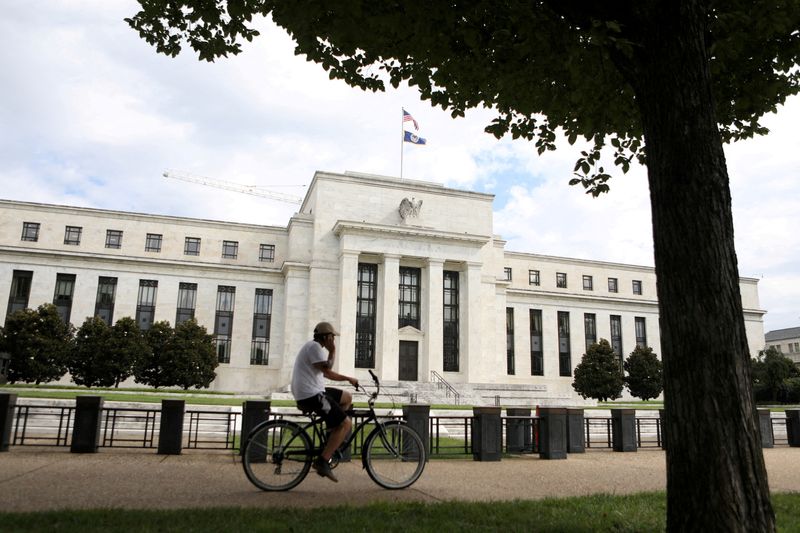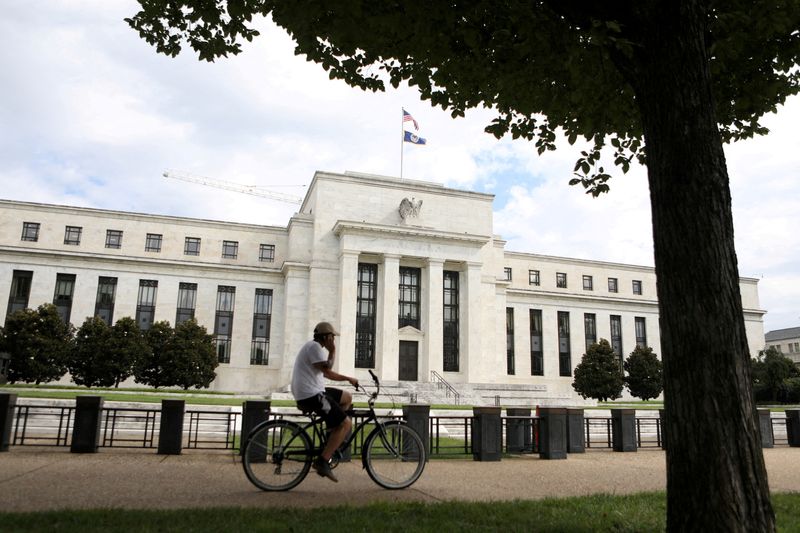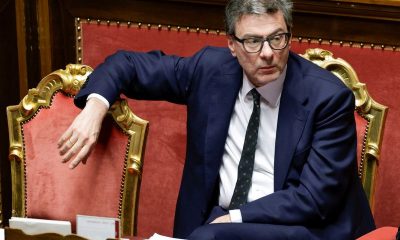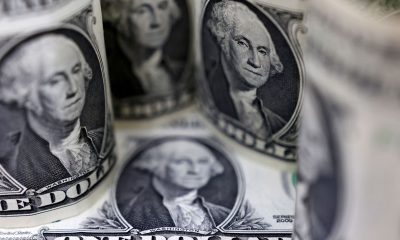Economy
Explainer-Charting the Fed’s data flow


© Reuters. FILE PHOTO: A cyclist passes the Federal Reserve building in Washington, DC, U.S., August 22, 2018. REUTERS/Chris Wattie/File Photo
By Howard Schneider
The Federal Reserve held its benchmark overnight interest rate steady at its Sept. 19-20 policy meeting. New data will shape whether the U.S. central bank continues to stand pat at its Oct. 31-Nov. 1 meeting or proceed with another rate increase.
The Fed’s target policy rate has been raised to the 5.25%-5.50% range from near zero in March of 2022, and inflation measured by the Fed’s preferred personal consumption expenditures price index (PCE) was 3.5% in August, compared to a peak of 7% last summer.
Fed Chair Jerome Powell has said the pieces of the low-inflation “puzzle” may be aligning, but he does not trust it yet.
Here is a guide to some of the numbers shaping the policy debate:
JOB OPENINGS: (Released Oct. 3, next release Nov. 1)
Powell keeps a close eye on the Labor Department’s Job Openings and Labor Turnover Survey (JOLTS) for information on the imbalance between labor supply and demand, and particularly on the number of job openings for each person without a job but looking for one. In August that key ratio clung to its downward trend as the Fed’s rate hikes have slowed labor market demand. It’s now about 1.5-to-1, compared with the nearly two jobs for every person seeking work during most of 2022. Levels around 1.2 were considered tight for the U.S. labor market before the pandemic.
INFLATION (Released Sept. 29, next release Oct. 12):
A key inflation measure fell in August, adding to what many economists feel is likely to be a steady disinflation. The PCE price index, stripped of volatile food and energy costs, rose 3.9% on a year-over-year basis compared to 4.3% in July, and recent month-to-month increases have averaged close to the Fed’s 2% target. The headline rate did increase slightly, from 3.4% to 3.5%, but largely on the basis of energy costs. The Fed uses the PCE measures to set its 2% inflation target, but the decline in the “core” measure will be seen as evidence of slower price increases ahead.
Consumer price inflation rose for the second straight month, to 3.7% in August versus 3.2% in July. But the rise was largely the result of higher gas prices, which can be volatile and which Fed officials discount in analyzing price trends. More important to the central bank, underlying “core” inflation stripped of energy and food costs continued its decline, falling to 4.3% on a year-over-year basis compared to 4.7% in July.
While the overall picture is somewhat mixed, the inflation data in recent months likely doesn’t change the policy outlook. But it does highlight the time it may take for Fed officials to be confident in a continued inflation decline.
INFLATION EXPECTATIONS (Released Sept. 29, next release Oct. 13)
Consumers’ estimates of what inflation will average over the next 12 months and the next five years fell notably in September, the University of Michigan reported. At the one-year horizon, the inflation expectation fell to 3.2% from 3.5% in August. At five years, the reading fell to 2.8% from 3.0%.
The declines will be comforting to Fed officials who worry that rising inflation expectations can make consumers act in ways that will keep actual inflation higher. The one-year rate, notably, is now around its 40-year average.
RETAIL SALES (Released Sept. 14, next release Oct. 17):
Retail sales rose more than expected in August, increasing 0.6%. While that was largely due to higher gasoline prices, a separate measure of sales more directly related to economic output also rose slightly even though economists expected it to decline. Even as prior months’ sales were revised lower, the August report showed household spending likely still adding to overall economic growth that has been on the central bank’s radar as an inflationary risk.
PRODUCER PRICES (Released Sept. 14, next release Oct. 11)
The producer price index (PPI) for August jumped 0.7%, the largest monthly increase since the peak of the Fed’s inflation worries in June of 2022. Goods prices spiked a full 2%, another reason the central bank will be reluctant to declare its inflation battle over. Yet much of that was due to a jump in fuel prices, the sort of thing the Fed will discount. An index of service industry prices rose just 0.2%, and a measure of retailer and wholesaler margins fell, reinforcing arguments that inflation should continue to fall.
EMPLOYMENT (Released Sept. 1, next release Oct. 6):
The U.S. economy added 187,000 jobs in August, more than economists expected, in a sign of continued labor market strength. But the August report also contained more than a little evidence that a slowdown is underway. Prior months’ gains were revised lower, with June job growth showing just 105,000 positions added, while the unemployment rate rose to 3.8% from 3.5% as more people joined the labor market.
Hourly wages grew at a brisk 4.3% on a year-over-year basis, but just 0.2% on a monthly basis, the smallest such jump this year.
Investors viewed the overall data as leaning against any further Fed rate increases.
BANK DATA: Released every Thursday and Friday
To some degree the Fed wants credit to become more expensive and less available. That is how increases in its policy rate influence economic activity. But bank failures in the spring threatened broader stress in the industry and a worse-than-anticipated credit crunch. Weekly data on bank lending shows bank credit has fallen on a year-over-year basis since the middle of July.
Bank borrowing from the Fed spiked around the failure of Silicon Valley Bank, but has declined since.
Economy
Russian central bank says it needs months to make sure CPI falling before rate cuts -RBC


© Reuters. Russian Central Bank Governor Elvira Nabiullina attends a news conference in Moscow, Russia June 14, 2019. REUTERS/Shamil Zhumatov/File Photo
MOSCOW (Reuters) – Russia’s central bank will need two to three months to make sure that inflation is steadily declining before taking any decision on interest rate cuts, the bank’s governor Elvira Nabiullina told RBC media on Sunday.
The central bank raised its key interest rate by 100 basis points to 16% earlier in December, hiking for the fifth consecutive meeting in response to stubborn inflation, and suggested that its tightening cycle was nearly over.
Nabiullina said it was not yet clear when exactly the regulator would start cutting rates, however.
“We really need to make sure that inflation is steadily decreasing, that these are not one-off factors that can affect the rate of price growth in a particular month,” she said.
Nabiullina said the bank was taking into account a wide range of indicators but primarily those that “characterize the stability of inflation”.
“This will take two or three months or more – it depends on how much the wide range of indicators that characterize sustainable inflation declines,” she said.
The bank will next convene to set its benchmark rate on Feb. 16.
The governor also said the bank should have started monetary policy tightening earlier than in July, when it embarked on the rate-hiking cycle.
Economy
China identifies second set of projects in $140 billion spending plan


© Reuters. FILE PHOTO: Workers walk past an under-construction area with completed office towers in the background, in Shenzhen’s Qianhai new district, Guangdong province, China August 25, 2023. REUTERS/David Kirton/File Photo
SHANGHAI (Reuters) – China’s top planning body said on Saturday it had identified a second batch of public investment projects, including flood control and disaster relief programmes, under a bond issuance and investment plan announced in October to boost the economy.
With the latest tranche, China has now earmarked more than 800 billion yuan of its 1 trillion yuan ($140 billion) in additional government bond issuance in the fourth quarter, as it focuses on fiscal steps to shore up the flagging economy.
The National Development and Reform Commission (NDRC) said in a statement on Saturday it had identified 9,600 projects with planned investment of more than 560 billion yuan.
China’s economy, the world’s second largest, is struggling to regain its footing post-COVID-19 as policymakers grapple with tepid consumer demand, weak exports, falling foreign investment and a deepening real estate crisis.
The 1 trillion yuan in additional bond issuance will widen China’s 2023 budget deficit ratio to around 3.8 percent from 3 percent, the state-run Xinhua news agency has said.
“Construction of the projects will improve China’s flood control system, emergency response mechanism and disaster relief capabilities, and better protect people’s lives and property, so it is very significant,” the NDRC said.
The agency said it will coordinate with other government bodies to make sure that funds are allocated speedily for investment and that high standards of quality are maintained in project construction.
($1 = 7.1315 renminbi)
Economy
Russian central bank says it needs months to make sure CPI falling before rate cuts -RBC


© Reuters. Russian Central Bank Governor Elvira Nabiullina attends a news conference in Moscow, Russia June 14, 2019. REUTERS/Shamil Zhumatov/File Photo
MOSCOW (Reuters) – Russia’s central bank will need two to three months to make sure that inflation is steadily declining before taking any decision on interest rate cuts, the bank’s governor Elvira Nabiullina told RBC media on Sunday.
The central bank raised its key interest rate by 100 basis points to 16% earlier in December, hiking for the fifth consecutive meeting in response to stubborn inflation, and suggested that its tightening cycle was nearly over.
Nabiullina said it was not yet clear when exactly the regulator would start cutting rates, however.
“We really need to make sure that inflation is steadily decreasing, that these are not one-off factors that can affect the rate of price growth in a particular month,” she said.
Nabiullina said the bank was taking into account a wide range of indicators but primarily those that “characterize the stability of inflation”.
“This will take two or three months or more – it depends on how much the wide range of indicators that characterize sustainable inflation declines,” she said.
The bank will next convene to set its benchmark rate on Feb. 16.
The governor also said the bank should have started monetary policy tightening earlier than in July, when it embarked on the rate-hiking cycle.

 Forex3 years ago
Forex3 years agoForex Today: the dollar is gaining strength amid gloomy sentiment at the start of the Fed’s week

 Forex3 years ago
Forex3 years agoUnbiased review of Pocket Option broker

 Forex3 years ago
Forex3 years agoDollar to pound sterling exchange rate today: Pound plummeted to its lowest since 1985

 Forex3 years ago
Forex3 years agoHow is the Australian dollar doing today?

 Cryptocurrency3 years ago
Cryptocurrency3 years agoWhat happened in the crypto market – current events today

 World3 years ago
World3 years agoWhy are modern video games an art form?

 Commodities3 years ago
Commodities3 years agoCopper continues to fall in price on expectations of lower demand in China

 Economy3 years ago
Economy3 years agoCrude oil tankers double in price due to EU anti-Russian sanctions



























